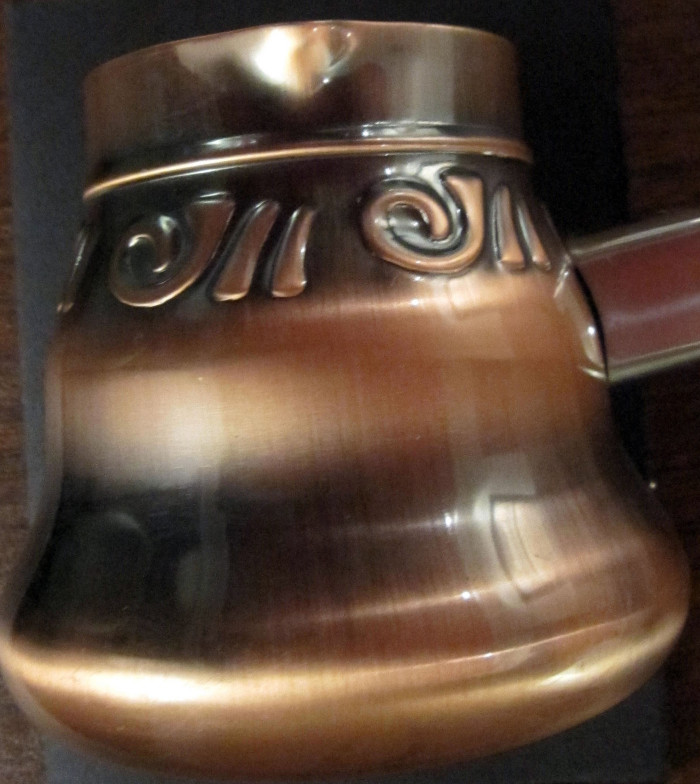Armenian Coffee Pot: "Surjep" or "Jazvah"
Collection: Commercial Connections
Armenian coffee is prepared in a "surjep" or "jazvah" coffee pot. According to folklore, when you visited friends and relatives, it was the custom to be served Surj (Armenian Coffee). In all the Near Eastern countries where Surj was served, it was the duty of the young girl in the house to prepare the coffee for all occasions. Surj is prepared with finely ground coffee beans and may or may not be sweetend. Traditionally, the girl who could not make a pot of coffee with a good foaming head on it was not worthy of a good husband. Armenian coffee powder is made from coffee beans that have been pulverized. The coffee is prepared in a surjep or jazvahh. Water is heated in the surjep until it is lukewarm. One heaped teaspoon of Armenian coffee and one teaspoon sugar is used for each cup, and stirred. Amounts may vary according to taste. As the mixture begins to boil, a thick foam should form. It is stirred once or twice. As the foam begins to rise, the pot is removed from the heat, so that the foam will sink down. This foaming and cooling process is repeated three times. Then the coffee is served. A little foam is poured into all of the cups first, then the remainder of coffee is poured, filling each cup to the brim.
Two main species of coffee trees are cultivated today. Coffea arabica, known as Arabica coffee, accounts for 75-80 percent of the world's production. Eighty percent of coffee from Brazil is Arabica. Coffea canephora, known as Robusta coffee, accounts for about 20 percent and differs from the Arabica coffees in terms of taste. Three to four years after the coffee is planted, sweetly smelling flowers grow in clusters in the axils of the coffee leaves. Fruit is produced only in the new tissue. The Coffea Arabica coffee plant is self-pollinating, whereas the Robusta coffee plant depends on cross pollination. About 6-8 weeks after each coffee flower is fertilized, cell division occurs and the coffee fruit remains as a pin head for a period that is dependent upon the climate. The coffee cherry will change color from green to red about thirty to thirty-five weeks after flowering and be ready to harvest. For the greatest success in production, coffee trees need a favourable climate: areas with hot-wet or hot-temperate climate, between the Tropic of Cancer and the Tropic of Capricorn, with frequent rains and temperatures varying from 15 to 25 degrees Centigrade. The trees thrive in deep, permeable, well-irrigated and well-drained subsoil. The best lands are the hilly ones, those cut into a mountainside, of volcanic nature with disintegrating rocks or from just-tilled woods. The perfect altitude is between 600 and 1200 metres, though some varieties thrive at 2000-2200 metres, and others at under 400 metres- or even on level land.
There are several legendary accounts of the origin of the coffee drink.The most popular involves a goat-herd, Kaldi, who, noticing the energizing effects when his flock nibbled on the bright red berries of a certain bush, chewed on the fruit himself. His exhilaration prompted him to bring the berries to a Muslim holy man in a nearby monastery. But the holy man disapproved of their use and threw them into the fire, from which an enticing aroma billowed. The roasted beans were quickly raked from the embers, ground up, and dissolved in hot water, yielding the world's first cup of coffee. The Ethiopian ancestors of today's Oromo tribe, were the first to have recognized the energizing effect of the native coffee plant. The earliest credible evidence of either coffee drinking or knowledge of the coffee tree appears in the middle of the fifteenth century, in the Sufi monasteries of the Yemen in southern Arabia. Coffee beans were first exported from Ethiopia to Yemen. Yemeni traders brought coffee back to their homeland and began to cultivate the bean. It was in Yemen that coffee beans were first roasted and brewed as they are today. From Mocha, coffee spread to Egypt and North Africa, and by the 16th century, it had reached the rest of the Middle East, Persia and Turkey. From the Muslim world, coffee drinking spread to Italy, then to the rest of Europe, and coffee plants were transported by the Dutch to the East Indies and to the Americas.
Source:
http://www.armenianheritage.com/facoffee.htm
http://www.ico.org/coffee_story.asp
http://en.wikipedia.org/wiki/History_of_coffee#Production
